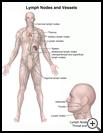
Lymph Nodes Swollen
What are lymph nodes?
Lymph nodes are small round shaped glands that are about the size of a pea or baked bean. The body contains more than 500 lymph nodes. Lymph nodes help prevent the spread of infection and protect the bloodstream from viral and bacterial invasion. Normal nodes are largest at age 10 to 12 years. At this age they can be twice the normal adult size. The easiest to feel are in the neck or groin.
Why do they swell?
Lymph nodes swell when they are fighting an infection.
- Nodes infected by a virus are usually 1/2 to 1 inch across. This slight enlargement and mild tenderness means the lymph node is fighting infection and succeeding.
- Nodes infected with bacteria are usually more than 1 inch across and very tender. If they are over 2 inches across or the overlying skin is pink, the nodes are not successfully controlling the infection and may contain pus.
Cuts, scrapes, scratches, splinters, burns, insect bites, rashes, impetigo, and any break in the skin will cause lymph glands to get larger. Try to locate and identify the cause of a swollen gland. If the nodes in the groin are swollen, look for an injury in the legs and lower abdomen. If the armpit nodes are swollen, examine the arms and upper chest. Swelling of the back-of-the-neck nodes suggests an irritation on the scalp. The front-of-the-neck nodes drain the lower face, nose, and throat, so an injury or infection in these areas might cause the nodes to swell. Most enlarged nodes in the neck are due to colds or throat infections. Swollen, tender node under the jawbone (mandible) can be caused by tooth decay and dental abscess A disease like chickenpox can cause all the nodes to swell.
How long will it last?
Viral infections and minor skin infections and irritations can cause lymph nodes to double in size quickly over 2 or 3 days. They return slowly to normal size over the next 2 to 4 weeks. However, they won't disappear completely.
You will always be able to see and feel nodes in most normal, healthy children, especially in the neck and groin.
How can I take care of my child?
- Treat the cause of swelling.
In general, no treatment is necessary for swollen nodes associated with viral infections (for example, colds). For bacterial infections, the disease that's causing the node to react needs to be treated. For example, remove the splinter, treat the Strep throat infection, treat the ingrown toenail, or have a dentist treat the tooth abscess. Many children with swollen lymph nodes due to a skin infection also need an oral antibiotic.
- Pain or fever relief.
For pain or fever above 102°F, give the appropriate dose of acetaminophen (Tylenol) or ibuprofen (Advil).
- Don't squeeze the nodes.
Poking and squeezing lymph nodes may keep them from shrinking back to normal size. Remember that it may take a month for the nodes to return to normal. They won't completely disappear. There's no need to check them more than once a month. If your child fidgets with them, discourage it if he's old enough to cooperate.
When should I call my child's healthcare provider?
Call IMMEDIATELY If:
- The node swells to 2 or more inches across.
- The overlying skin becomes red.
- Your child has trouble swallowing or breathing.
- Your child starts acting very sick.
Call within 24 hours if:
- The node swells to 1 to 2 inches across.
- Your child also develops sore throat.
- A fever persists more than 3 days.
- You have other questions or concerns.
Last modified: 2011-06-07
Last reviewed: 2017-06-05

